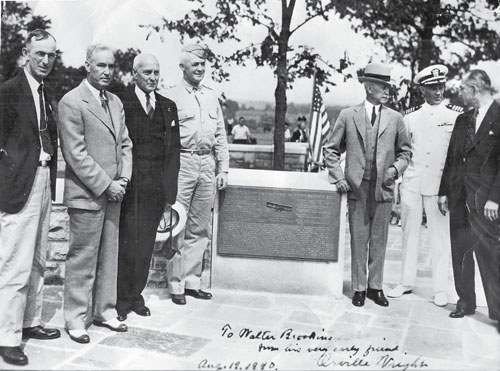
The History Rescue


In 1951, aviation enthusiasts from southern California formed organizations to preserve the documents, artifacts and oral histories of early flyers. Many ideas faded into obscurity, none more well-intentioned than the “Santos Dumont Aeronautical Foundation (SDAF).” The SDAF was formed to create a “Hall of Aviation History” located in Burbank. Among its most avid supporters was James N. Gillette, an employee of Pierce Brothers Valhalla Cemetery, which lay adjacent to Burbank’s airport. The SDAF sold copies of the above photograph for one dollar to raise funds to purchase land. This copy of the original, signed by Orville Wright, once belonged to Gillette and was tossed into the trash during repairs to the cemetery offices following the Northridge earthquake in 1994.
This picture was taken on August 19, 1940, Orville Wright’s sixty-ninth birthday, at Wright Hill overlooking Huffman Prairie in Dayton, Ohio. The occasion was the dedication of a 30-foot marble memorial commemorating the fields below, where the Wrights flew their early aeroplanes and taught America’s first flyers at the Wright’s flying school. Behind the monument, on a stone wall, the commemorative plaque lists students of the flying school. Many dignitaries attended the dedication, but pictured here is a remarkable assemblage of U.S. aviation pioneers. As early aviators, each of these men made repairs to their aircraft. All held leadership positions in business, government or military.
Roderick M. Wright
Roderick M. Wright (1887-1960) never strayed far from his family farm in Washington, Ind. — except to fly. Wright (no relation to Orville and Wilbur) earned his aviator’s license at the Wright School in 1913, and then became their instructor and exhibition team pilot. During the 1930s, he was a test pilot associated with aircraft companies such as Stinson and Ford, and was also a civilian test pilot for the Army. He contracted to test parachutes on his farm during WWII. He was elected to the Indiana House of Representatives and lived on his farm until he became ill and (in his own wording) “slipped over the edge.”
Bernard Whalen
I have searched for a biography of Bernard Whalen without success. In an undated description on the reverse of the photograph, Whalen is described as an “early pilot now with the helicopter division of Sikorsky Aircraft.”
Robert G. Fowler
Robert G. Fowler (1884-1966) is best known for his 1911 attempt to claim the $50,000 Hearst Prize as the first to cross the U.S. in 30 days or less. Fowler flew west to east. His competition, Calbraith Rogers, entered the race flying east to west. Neither won the prize, but both became famous for multiple crack-ups along the way. Fowler was raised in San Francisco and raced cars while in his teens. He attended the Wright School in 1911 and, following his failed attempt at the Hearst prize, he made a name for himself “flying nonstop from the Atlantic to the Pacific.” During his 50-mile flight over the Isthmus of Panama in 1913, his passenger filmed construction of the Panama Canal. He was a showman, a businessman and inventor. He was head of LWF Engineering and the Fowler Aeroplane Company in California before WWI. In his later years, Fowler wrote for several publications and remained active in aviation clubs.
“Hap” Arnold
At the time this photograph was taken, Henry H. Arnold (1886-1950), or “Hap,” as he was nicknamed by co-workers, was Chief of the Army Air Corps, and the U.S. had not yet entered WWII. Arnold was born in Pennsylvania and known to be athletic and congenial. He graduated from the U.S. Military Academy and trained at the Wright School in Ohio becoming the second Army officer to receive an aviator’s license. Representing the Signal Corp, Arnold flew a Wright “B” at the Nassau Boulevard Air Meet on Long Island, NY, in 1911. His flying experience earned him the command of the Army’s Air Service at Rockwell Field, San Diego, in 1912. He expanded military aviation during and after WWI. By WWII, he was Commander of the Army Air Force. Arnold became a five-star general and was awarded many honors for his service that spanned almost 40 years.
Orville wright
Central to this commemorative occasion is Orville Wright (1871-1948), who was 69 years old at the time. His brother, Wilbur, had died of an illness in 1912. The Wright brothers lived most of their lives in Ohio and were part of a close-knit family that including one sister, Katharine. The brothers ran a bicycle shop together and eventually became interested in the theory of manned flight. Their story is familiar and well documented. In 1903, while testing their flying machine at Kitty Hawk, N.C., Orville became the first person in the world to fly an aeroplane. Before WWI, the Wrights further developed their aircraft, competing with international inventors. In 1908, while piloting a demonstration flight to procure a military contract at Fort Myer, Va., Orville lost control of the aircraft and his passenger, Thomas Selfridge, was killed. Orville was badly injured. Orville sold the Wright Company in 1915 but remained on the board of several aviation businesses for decades. He continued “tinkering” in his Dayton laboratory until he died. Tom Crouch, his biographer, wrote, “He was a born inventor whose fingers itched for a screwdriver and pliers.”
Kenneth Whiting
Kenneth Whiting (1881-1943) had just retired as Captain of the U.S. Navy’s aircraft carrier Saratoga when he joined this austere group at Dayton. He died three years later, at age 62, while on active duty in Command of Naval Air Station, N.Y. Whiting was born in Massachusetts and graduated from the Naval Academy, to be commissioned as an Ensign in 1908. He commanded submarines until his interest switched to aviation. He graduated from the Wright School in 1914 and became Naval Aviator No. 16. (Theodore “Spuds” Ellyson was Naval Aviator No. 1 in 1911 and was taught by Glenn Curtiss.) Whiting commanded air squadrons and was integral in the development of the Navy’s aircraft carrier fleet. Eight months after Whiting’s death, the U.S. Navy launched the Kenneth Whiting (AV-14) at Seattle and it was commissioned for active service in 1944.
Walter E. Brookins
Walter E. Brookins (1889-1953) was a native of Dayton. He met the Wright family when he was four years old and they nicknamed him “Brookie.” He was also a grammar school student of Katharine Wright. He was a curious teen and hung around the Wright’s bicycle shop where he also learned about their flying experiments. When the Wrights set up their flying school in Montgomery, Ala., Brookins was among their first students. He sat next to Orville in their dual-control aircraft during a short training period and soon soloed. When Orville returned to Dayton, he left Brookins in Alabama to become their first instructor. In 1910, Brookins was chosen to be among the first members of the Wright Exhibition Flying Team. His first and most serious accident occurred when he dove his aircraft into the ground to avoid hitting a cluster of newspaper reporters who ignored instructions to clear his landing area. He eventually moved to California and headed a company that produced aircraft parts. He remained active in aviation organizations for the rest of his life.
The portal of folded wings
With Brookins we come full circle to the connection with Gillette. The SDAF failed to complete its goal for a “Hall of Aviation History,” but Gillette was instrumental in establishing the Portal of the Folded Wings at Valhalla cemetery as the final resting place for pioneer aviators. In 1953, Brookins was first of the original 13 pioneer aviators to be buried under the dome of the Portal. Gillette rests just feet from the entrance of the Portal, where aircraft roar above.

Giacinta Bradley Koontz is an aviation historian, magazine columnist and author. In 2008, she was awarded the National DAR History Medal and has appeared in documentaries on PBS and The History Channel. Learn more about her aviation history projects at www.harrietquimby.org.
